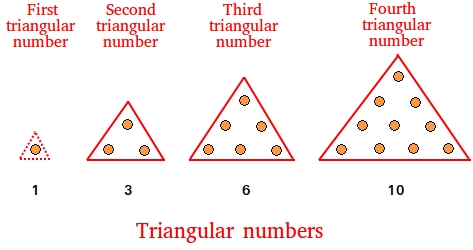Triangular numbers
Triangular numbers are numbers that represent the shapes that you see below.
My goal is to help you examine the pattern and derive a formula. Notice that 1 dot does not really give us the shape of a triangle. What we can do is pretend in our mind that it has the shape of a triangle. Need more information on why it is OK to pretend that 1 has the shape of a triangle?

Here is how to derive a formula that can help us find triangular numbers
Here is how to proceed:First number: 1
Second number: 3 = 1 + 2
Third number: 6 = 1 + 2 + 3
Fourth number: 10 = 1 + 2 + 3 + 4
Hundredth number: ? = 1 + 2 + 3 + 4 + 5 + 6 +....+ 100
Instead of adding in that order, you can add as shown below (credited to Gauss)
(1 + 100) + (2 + 99) + (3 + 98) + (4 + 97) + ......+ (50 + 51)
Notice that each pair is equal to 101. Furthermore, since we are pairing the numbers, and there are 100 numbers, there will be 50 pairs.
Therefore, instead of adding 101 fifty times, you can just multiply 101 by 50
Since 50 × 101 = 5050, the sum for 1 + 2 + 3 + 4 + 5 + 6 +....+ 100 is equal to 5050
You can play with 50 × 101 to get a general formula.
If we can rewrite 50 × 101 and make 100 appear into the expression, we can just make a prediction and say that 100 represents the hundredth number.
Then, we can simply replace 100 by n and n will represent the nth number.
It is not a complete proof. You just make a sound and logical conclusion based on a pattern.
50 × 101 = (100/2) × 101 = (100/2) × (100 + 1)
If we substitute 100 for n, the formula we get is (n/2) × (n + 1)
Now let's test the formula for the first 4 numbers above
First number: (1/2) × (1 + 1) = (1/2) × 2 = 1
Second number: (2/2) × (2 + 1)= 1 × (2 + 1) = 1 × 3 = 3
Third number: (3/2) × (3 + 1) = 3/2 × 4 = 12/2 = 6
Fourth number: (4/2) × (4 + 1) = 4/2 × 5 = 2 × 5 = 10
Since the formula is working for 5 numbers, you have a pattern and it is reasonable to conclude that it will work for all triangular numbers